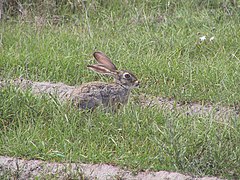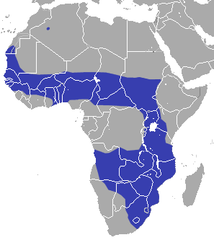Zając sawannowy
| Lepus victoriae[1] | |||||
| O. Thomas, 1893[2] | |||||

| |||||
| Systematyka | |||||
| Domena | |||||
|---|---|---|---|---|---|
| Królestwo | |||||
| Typ | |||||
| Podtyp | |||||
| Gromada | |||||
| Rząd | |||||
| Rodzina | |||||
| Rodzaj | |||||
| Gatunek |
zając sawannowy | ||||
| |||||
| Podgatunki | |||||
| |||||
| Kategoria zagrożenia (CKGZ)[18] | |||||
 | |||||
| Zasięg występowania | |||||
 Zasięg zająca Lepus microtis | |||||
Zając sawannowy[19] (Lepus victoriae[20]) – gatunek afrykańskiego ssaka z rodziny zającowatych (Leporidae).
Zasięg występowania
[edytuj | edytuj kod]Zając sawannowy występuje od wybrzeża Oceanu Atlantyckiego w północno-zachodniej Afryce (Sahara Zachodnia na południe do Gwinei), na wschód przez Sahelu do Sudanu i skrajnie zachodniej Etiopii, na południe przez wschodnią Afrykę (wschodnia Demokratyczna Republika Konga, Uganda, zachodnia Kenia, Rwanda, Burundi i Tanzania) do większej części Angoli, Zambii, Malawi, północno-wschodniej Namibii, Botswany, Zimbabwe, Mozambiku, wschodniej Południowej Afryki, Eswatini i Lesotho; występuje mała izolowana populacja w pobliżu Beni Abbas na Saharze w zachodniej Algierii[21]. Podgatunki zamieszkują w[21]:
- L. victoriae victoriae – Tanzania.
- L. victoriae angolensis – Angola.
- L. victoriae senegalensis – Senegal, Gambia.
- L. victoriae whytei – Malawi.
Taksonomia
[edytuj | edytuj kod]Gatunek po raz pierwszy opisany został przez Theodora von Heuglina w 1865 pod nazwą Lepus microtis. Pod nazwą victoriae został opisany w 1893 roku przez angielskiego zoologa Oldfielda Thomasa[2]. Holotyp pochodził z Nassy, z zatoki Speke, w południowo-wschodnim obszarze Jeziora Wiktorii, w Tanzanii[21]. Występował pod nazwami L. saxatilis, L. crawshayi, L. whytei. W 1964 Gurev umieścił go w podrodzaju Proeulagus. Do podrodzaju Sabanalagus przeniesiony został przez Averianova w 1998. Gatunek jest symapatryczny dla zająca zaroślowego (L. saxtalis) oraz para- do allopatrycznego dla zająca przylądkowego (L. capensis) oraz zająca abisyńskiego (L. habessinicus)[22]. Jego kariotyp 2n=48 oraz morfologia chromosomów wskazują na pokrewieństwo rodzaju Lepus z króliczakiem wulkanicznym (Romerolagus diazi)[23].
Autorzy Illustrated Checklist of the Mammals of the World rozpoznają cztery podgatunki, lecz ich rozróżnienie może być arbitralne i nieuzasadnione[21].
Etymologia
[edytuj | edytuj kod]- Lepus: łac. lepus leporis „królik, zając”[24].
- victoriae: jezioro Wiktoria, Afryka Wschodnia[25].
- angolensis: Angola[25].
- senegalensis: Senegal[25].
- whytei: Alexander Whyte (1834–1905), brytyjski przyrodnik rządowy w Nyasaland w latach 1891–1897[26].
Morfologia
[edytuj | edytuj kod]Długość ciała (bez ogona) 420–580 mm, długość ogona 68–121 mm, długość ucha 90–120 mm, długość tylnej stopy 103–127 mm; masa ciała 1,4–3,2 kg[20].
Przypisy
[edytuj | edytuj kod]- ↑ Lepus victoriae, [w:] Integrated Taxonomic Information System (ang.).
- ↑ a b O. Thomas. Descriptions of two new rodents from the Victoria Nyanza. „The Annals and Magazine of Natural History”. Sixth series. 12, s. 268, 1893. (ang.).
- ↑ T. von Heuglin. Weitere Einsendung an die Kaiserl. Leopold. – Carol. deutsche Akademie der Wissenschaften, mit zoologischen Notizen aus Afrika. „Novorum actorum Academiae Caesareae Leopoldino-Carolinae Germanicae Naturae Curiosorum”. 32, s. 32, 1865. (ang.).
- ↑ A.T. Rochebrune. Faune de la Sénégambie. Mammifères. „Actes de la Société Linnéenne de Bordeaux”. Quatrième série. 7, s. 120, 1883. (fr.).
- ↑ O. Thomas. On the Mammals of Nyasaland: third Contribution. „Proceedings of the Zoological Society of London”. 1894, s. 142, 1894. (ang.).
- ↑ W.E. de Winton. On two hares from British East Africa, obtained by Mr. Richard Crawshay. „Proceedings of the Zoological Society of London”. 1899 (2), s. 416, 1899. (ang.).
- ↑ P. Matschie. Über Säugethiere aus den Sammlungen des Herrn Graf Zech in Kratyi, Togo. „Sitzungsberichte der Gesellschaft Naturforschender Freunde zu Berlin”. Jahrgang 1899, s. 11, 1899. (niem.).
- ↑ Heller 1912 ↓, s. 18.
- ↑ Heller 1912 ↓, s. 19.
- ↑ O. Thomas. On mammals from northern Angola collected by Dr. W. J. Ansorge. „The Annals and Magazine of Natural History”. Seventh series. 13, s. 420, 1904. (ang.).
- ↑ O. Thomas & R.Ch. Wroughton. On a second collection of mammals obtained by Dr. W. J. Ansorge in Angola. „The Annals and Magazine of Natural History”. Seventh series. 16, s. 176, 1905. (ang.).
- ↑ O. Thomas & H. Schwann. The Rudd Exploration of South Africa.—III. List of the Mammals obtained by Mr. Grant in Zululand. „Proceedings of the Zoological Society of London”. 1905 (1), s. 270, 1905. (ang.).
- ↑ E.C. Chubb. On a new Rhodesian hare. „The Annals and Magazine of Natural History”. Eight series. 1, s. 466, 1908. (ang.).
- ↑ O. Thomas & M.A.C. Hinton. Captain Angus Buchanan's Aïr Expedition. II. On the mammals (other than ruminants) obtained during the expedition to Aïr (Asben). „Novitates zoologicae”. 28 (1), s. 12, 1921. (ang.).
- ↑ O. Thomas. On mammals from Ovamboland and the Cunene River, obtained during Capt. Shortridge's third Percy Sladen and Kaffrarian Museum Expedition into South-West Africa. „Proceedings of the Zoological Society of London”. 1926 (1), s. 308, 1926. (ang.).
- ↑ A. Monard. Mission scientifique suisse dans l’Angola: résultats scientifiques: mammifères. „Bulletin de la Société neuchâteloise des sciences naturelles”. 57, s. 61, 1932. (fr.).
- ↑ R.T. Hatt. „Revue de zoologie et de botanique africaines”. 26, s. 423, 1935. (fr.).
- ↑ C.H. Johnston i inni, Lepus victoriae, [w:] The IUCN Red List of Threatened Species 2019, wersja 2021-2 [dostęp 2021-09-23] (ang.).
- ↑ W. Cichocki, A. Ważna, J. Cichocki, E. Rajska-Jurgiel, A. Jasiński & W. Bogdanowicz: Polskie nazewnictwo ssaków świata. Warszawa: Muzeum i Instytut Zoologii PAN, 2015, s. 58. ISBN 978-83-88147-15-9. (pol. • ang.).
- ↑ a b S. Schai-Braun & K. Hackländer: Family Leporidae (Hares and Rabbits). W: D.E. Wilson, T.E. Lacher, Jr & R.A. Mittermeier (redaktorzy): Handbook of the Mammals of the World. Cz. 6: Lagomorphs and Rodents I. Barcelona: Lynx Edicions, 2016, s. 131. ISBN 978-84-941892-3-4. (ang.).
- ↑ a b c d C.J. Burgin, D.E. Wilson, R.A. Mittermeier, A.B. Rylands, T.E. Lacher & W. Sechrest: Illustrated Checklist of the Mammals of the World. Cz. 1: Monotremata to Rodentia. Barcelona: Lynx Edicions, 2020, s. 286. ISBN 978-84-16728-34-3. (ang.).
- ↑ Lepus microtis in: Wilson & Reeder's Mammal Species of the World 3d Ed.. [dostęp 2013-10-25].
- ↑ T.J. Robinson, Frederick F. B. Elder, W. Lopez-Forment. Banding Studies In The Vulcano Rabbit, Romerolagus diazi and Crawshay’s Hare Lepus Crawshayi. Evidece of the Leporid Ancestral Kariotype. „Canadian Journal of Genetics and Cytology”. 23 (3), s. 469-474, 1981.
- ↑ T.S. Palmer. Index Generum Mammalium: a List of the Genera and Families of Mammals. „North American Fauna”. 23, s. 373, 1904. (ang.).
- ↑ a b c The Key to Scientific Names, J.A. Jobling (red.), [w:] Birds of the World, S.M. Billerman et al. (red.), Cornell Lab of Ornithology, Ithaca (ang.).
- ↑ B. Beolens, M. Watkins & M. Grayson: The Eponym Dictionary of Mammals. Baltimore: The Johns Hopkins University Press, 2009, s. 444. ISBN 978-0-8018-9304-9. (ang.).
Bibliografia
[edytuj | edytuj kod]- E. Heller. New rodents from British East Africa. „Smithsonian miscellaneous collections”. 59 (16), s. 1–20, 1912. (ang.).
